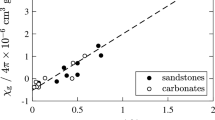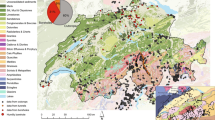Abstract
We will describe a new laboratory system which was designed to be highly automated and portable while maintaining quality. Driving this design was the recognition of the temporal dependence of physical properties. It becomes apparent that some sedimentary rocks, particularly shales, degrade and disaggregare so completely that mechanical or elastic properties cannot be measured. This temporal dependence displays a time scale much shorter than normal weathering but greater than the time for stress relief. A system was designed to permit field characterization of freshly recovered core material. A benefit of automation and portability is a marked increase in measurement efficiency. The attributes of this system permit rapid characterization of a large number of fresh cores in remote, frontier exploration areas. This feature can significantly reduce prospect evaluation time. Statistically significant rock property databases can be created in a short period of time.
Similar content being viewed by others
References
Aki, K., andRichards, P. G.,Quantitative Seismology Theory and Methods, vol. I (W. H. Freeman and Co., San Francisco 1980) 557 pp.
API (1960),Recommended Practice for Core Analysis Procedure, American Petroleum Institute RP-40.
Bher, H. J., Kehrer, P., andRischmuller, H.,The German continental deep drilling program, objectives and state of work. InDeep Drilling in Crystalline Bedrock, vol. 2 (eds. Boden, A. and Erikson, K. G.), (Springer-Verlag, New York 1988) pp. 64–81.
Biot, M. M. (1956a),Theory of Propagation of Elastic Waves in a Fluid-saturated Porous Solid. I. Low-frequency Range, J. Acoust. Soc. Am.28, 168–178.
Biot, M. M. (1956b),Theory of Propagation of Elastic Waves in a Fluid-saturated Porous Solid. II. Higher-frequency Range, J. Acoust. Soc. Am.28, 179–191.
Bortfeld, R. (1961),Approximation to the Reflection and Transmission Coefficients of Plane Longitudinal and Transverse Waves, Geophys. Prospect9, 485–502.
Castagna, S. P., Batzle, M. L., andEastwood, R. L. (1985),Relationships between Compressionalwave and Shear-wave Velocities in Clastic Silicate Rocks, Geophysics15 (4), 571–581.
Christensen, N. J.,Seismic velocities. InHandbook of Physical Properties for Rocks, II (ed. Carmichael, R. S.) (CRC Press Inc. 1982).
Déliac, E. P., Messines, J. P., andThierrée, B. A. (1991),Mining Technique Finds Applications in Oil Exploration, Oil and Gas J., May 6, 85–90.
Enderlin, M. B., Hanson, D. K. T., andHoyt, B. R. (1991),Rock Volumes: Considerations for Relating Well Log and Core Data in Reservoir Characterization. II (eds. Lake, L. W., Carroll, H. B. Jr., and Wesson, T. C.) (Academic Press, New York 1991) pp. 277–288.
Freund, D. (1992),Ultrasonic Compressional and Shear Velocities in Dry Elastic Rocks as a Function of Porosity, Clay, Content, and Confining Pressure, Geophys. J. Int.108, 125–135.
Griffiths, P. R., andDe Haseth, J. A.,Fourier Transform Infrared Spectrometry (John Wiley, New York 1986).
Gunn, K. B. (1991),Well Cored to 9,800 ft in Paraguay, Oil and Gas J., 51–55, May 13.
Han, D., Nur, A., andMorgan, D. (1986),Effects of Porosity and Clay Content on Wave Velocities in Sandstones, Geophys.51, 2093–2107.
Jones, L. E. A., andWang, H. F. (1981),Ultrasonic Velocities in Cretaceous Shales from the Williston Basin, Geophys.46, 288–297.
Justice, J. H., Vasslliou, A. A., Singh, S., Logel, J. D., Hansen, P. A., Hall, B. R., Hutt, P. R., andSolanki, J. J. (1989), Geophysics: The Leading Edge, 12–19, Feb.
Kent, D. V. (1991),Continental Drilling Program to Establish Fundamental Data Base for Rift Basin Evolution Models, CSD News2, 1–2.
Kozlovsky, Y. A. (editor),The Super Deep Well of the Koal Peninsula (Springer-Verlag, New York 1986) 558 pp.
Lines, L. (1991),Applications of Tomography to Borehole and Reflection Seismology, Geophysics: The Leading Edge, 11–17.
Mavko, G., andJizba, D. (1991),Estimating Grain-scale Fluid Effects on Velocity Dispersion in Rocks, Geophys.56, 1940–1949.
Mueller, M. C. (1991),Prediction of Lateral Variability in Fracture Intensity Using Multicomponent Shear-wave Surface Seismic as a Precursor to Horizontal Drilling in the Austin Chalk, Geophys. J. Int.107 (3), 409–415.
O'Connell, R. J., andBudiansky, B. (1974),Seismic Velocities in Dry and Saturated Cracked Solids, J. Geophys. Res.7935, 5417–5426.
Oliver, J. E.,The Incomplete Guide to the Art of Discovery (Columbia Univ. Press 1991) 208 pp.
Ostrander, W. J. (1984),Plane-wave Reflection Coefficients for Gas Sands at Non-normal Angle of Incidences, Geophys.49, 1637–1648.
Pickett, G. R. (1963),Acoustic Character Logs and their Applications in Formation Evaluation, J. Petr. Tech.15, 650–667.
Randolph, S. B., andJourdan, A. P. (1991),Slimhole Continuous Coring and Drilling in Tertiary Sediments, Paper SPE/IADC 21906, SPE/IADC Drilling Conference, Amsterdam March 11–14.
Robertson, J. D. (1989),Reservoir Management Using 3-D Seismic Data, Geophysics: The Leading Edge, 25–31, Feb.
Schreiber, E., Anderson, O. L., andSoga, N.,Elastic Constants and their Measurement (McGraw-Hill Book Co., NY 1973) 196 pp.
Shuey, R. T. (1985),A Simplification of the Zoeppritz Equations, Geophys.50, 609–614.
Sondergeld, C. H., andRai, C. S. (1992),Laboratory Observations of Shear-wave Propagation in Anisotropic Media, Geophysics: The Leading Edge11, 38–43, Feb.
Teufel, L. W. (1983),Determination of in situ Stress from Anelastic Strain Recovery Measurements of Oriented Core, SPF/DOE Symp, 11649, Denver, CO 421–430.
Walker, S. H., andMilheim, K. K. (1990),An Innovative Approach to Exploration and Exploitation Drilling: The Slim-hole, High-speed, Drilling System, J. Petrol. Tech.42 (9), 1184–1191.
Ward, J., Randazzo, S., Lieber, R., andSmith, R. (1991),Synthetic Shear Wave Sonic Logs for Seismic Models, poster presented at SEG Research Workshop on Lithology: Relating elastic properties to Lithology at all scales, July 28, St. Louis, MO.
Winkler, K. W. (1986),Estimates of Velocity Dispersion between Seismic and Ultrasonic Frequencies, Geophys.51 (1), 183–189.
Wolter, K. E., andBerckhemer, H. (1990),Estimation of in situ Stresses by Evaluation of Time-dependent Strain Recovery of KTB Drill Cores, Tectonophys.178, 255–259.
Zoback, M. A., Silver, L. T., Henyey, T., andThatcher, W. (1988),The Cajon Pass Scientific Drilling Experiment Overview of Phase 1, Geophys. Res. Lett.15, 933 pp.
Author information
Authors and Affiliations
Rights and permissions
About this article
Cite this article
Sondergeld, C.H., Rai, C.S. A new exploration tool: Quantitative core characterization. PAGEOPH 141, 249–268 (1993). https://doi.org/10.1007/BF00998331
Received:
Revised:
Accepted:
Issue Date:
DOI: https://doi.org/10.1007/BF00998331




